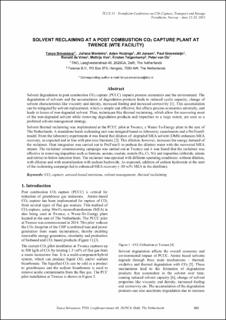| dc.description.abstract | Solvent degradation in post combustion CO2 capture (PCCC) impacts process economics and the environment. The degradation of solvents and the accumulation of degradation products leads to reduced cyclic capacity, change of solvent characteristics like viscosity and density, increased fouling and increased corrosivity [1]. This accumulation can be mitigated by solvent replacement, which is simple and effective, but affects process economics adversely, and leads to losses of non-degraded solvent. Thus, techniques like thermal reclaiming, which allow for recovering most of the non-degraded solvent while removing degradation products and impurities to a large extent, are seen as a preferred solvent management strategy. Solvent thermal reclaiming was implemented at the PCCC pilot at Twence, a Waste-To-Energy plant in the east of The Netherlands. A standalone batch reclaiming unit was designed based on laboratory experiments and a ProTreat® model. From the laboratory experiments it was found that dilution of degraded MEA solvent (DMS) enhances MEA recovery, as expected and in line with previous literature [2]. This dilution, however, increases the energy demand of the reclaimer. Heat integration was carried out in ProTreat® to preheat the dilution water with the recovered MEA stream. The reclaimer commissioning campaign was carried out at Twence and it was found that the reclaimer was effective in removing impurities such as formate, acetate, oxalate, metals (Fe, Cr, Ni) and impurities (chloride, nitrate and nitrite) to below detection limit. The reclaimer was operated with different operating conditions: without dilution, with dilution and with neutralization with sodium hydroxide. As expected, addition of sodium hydroxide at the start of the reclaiming campaign led to enhanced MEA recovery (~20 wt% MEA in the distillate). | en_US |

